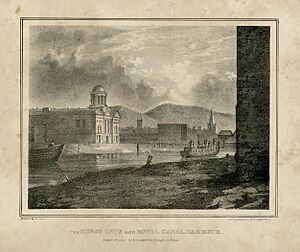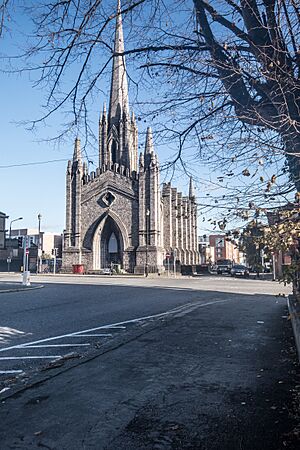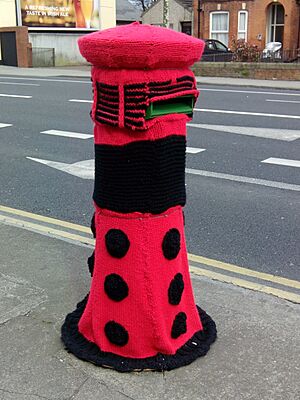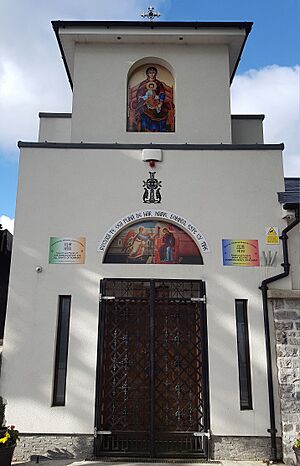Broadstone, Dublin facts for kids
Quick facts for kids
Broadstone
An Clochán Leathan
|
|
|---|---|
|
Inner suburban area
|
|
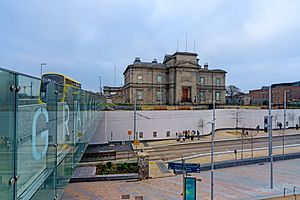
Broadstone Station. This building was once a busy railway station. Now, it's a bus depot for Dublin Bus.
|
|
| Country | Ireland |
| Province | Leinster |
| City | Dublin |
| Dáil Éireann | Dublin Central |
| European Parliament | Dublin |
| Elevation | 13 m (43 ft) |
Broadstone (Irish: An Clochán Leathan) is a neighbourhood in Dublin, Ireland. It is one of three areas that make up Phibsboro. Broadstone is about two kilometres north of Father Mathew Bridge.
The area has a triangular shape. It is bordered by Phibsborough Road and Constitution Hill to the west. To the north is the North Circular Road. Dorset Street and Bolton Street are to the south-east. The postal code for Broadstone is Dublin 7.
Contents
What is Broadstone like?
Broadstone was once called Glasmanogue. This name described a place where people could cross the Bradogue stream. The Bradogue is a small stream that flows into the Liffey. It starts in Cabra and now flows mostly underground.
Broadstone is home to several important places. These include the Black Church, King's Inns, the Broadstone Station, and the Blessington Street Basin. Many of the houses here are made of red brick. They were built for railway workers about a century after the first Georgian Dublin homes. These houses often have fancy doorways with half-circle windows above them.
Broadstone doesn't have a main street or a village centre. The old railway station was the most important spot. Broadstone was one of Dublin's six main railway stations, which made it a very important area.
Broadstone's History
Early Days
The Vikings settled this area a long time ago. It was part of the Grangegorman estate, which was famous for its fruit orchards. The green areas were used for grazing animals and for fun. In the late 1700s, it was a wet, muddy place. The old Irish name, Glas Mochanog, means 'Monck Green'.
After 1660, the area was used for military parades. It celebrated the return of King Charles II to the throne. Broadstone became part of Dublin city in the late 1700s. This happened when the Royal Canal was built. Wealthy families, like the Gardiners, moved to this part of the city. Many streets nearby are named after them.
The Royal Canal
In 1789, Dublin decided to build the Royal Canal. A harbour was built on Constitution Hill. It connected to the main canal at Phibsboro. The history of Broadstone is closely linked to this canal. The harbour opened in 1806. Its location was chosen because it was close to markets and law courts.
By 1807, boats regularly travelled from Dublin to Mullingar. The area became very busy with hotels and inns. Trade boats used the harbour to load and unload goods. The canal eventually connected to the River Shannon in 1817. In 1810, the Blessington Street Basin was dug. This reservoir supplied water to the area.
In the 1830s, the canal carried about 80,000 tons of goods and 40,000 passengers each year.
The King's Inns
The King's Inns is the oldest place for legal education in Ireland. It was founded in 1542. It moved to Constitution Hill in the 1790s. The current building was designed by James Gandon. It was built opposite the harbour, like his other famous buildings. Construction started in 1800 and finished in 1823.
Many famous people studied here after it moved to Broadstone. These include Patrick Pearse and Mary Robinson.
The Black Church
St. Mary's Chapel of Ease is known as the Black Church. It was built in 1830 by John Semple. People think it got its nickname because the inside was very dark. The church has thick walls and narrow windows. Inside, it has a unique curved ceiling that looks like a parabolic arch.
There's a fun legend about the Black Church. It says if you walk around it backwards three times at midnight, you might meet the Devil! This story probably started because it was a Protestant church. The building is no longer used for religious services. It is now used as offices.
The Black Church is mentioned in the famous book Ulysses by James Joyce. Joyce lived in Broadstone for a while. He stayed at 44 Fontenoy Street. He also tried to open the first cinema in Dublin. The poet Austin Clarke also grew up in Broadstone. He wrote a book called "Twice Round the Black Church." Both Clarke and Joyce went to Belvedere College nearby.
Midland Great Western Railway and Broadstone Station
In 1845, the Midland Great Western Railway Company bought the Royal Canal. They wanted to build a railway line next to it. Broadstone railway station was finished in 1850. It was one of Dublin's first six main railway stations.
The station was designed by John Skipton Mulvany. It is made of granite and looks like an ancient Egyptian building. Broadstone Station was the main station for trains going to the west of Ireland. The railway helped transport many people and cattle.
Many houses in Broadstone were built around this time. They were for the railway workers. These homes are often called Artisan cottages.
Decline of the Canal and Railway
The Great Irish Famine in the mid-1800s caused many people to leave Ireland. This meant fewer people lived in the west, which was the railway's main market. The canal system also became less used.
In 1877, the railway company was allowed to close part of the canal branch. They filled in the harbour to make a new area for the station. The harbour was no longer needed because a bigger one was built at Spencer Dock.
By the 1920s, the Royal Canal carried much less cargo. In 1924, the Midland Great Western Railway joined with another company. This helped them survive. In 1927, the canal and railway were permanently separated.
The railway also started to decline. The last train left Broadstone in 1937. In 1944, the canal and railway became part of the state transport company, Córas Iompair Éireann (CIÉ). Broadstone Station closed in 1961. Today, the historic station building is used as offices by Bus Éireann. The rest of the site is used for parking and servicing buses.
Broadstone Today
After the railway closed, the area faced tough times. The park at Royal Canal Bank and the old reservoir at Blessington Street were neglected.
The Irish Youth Hostelling Association, An Óige, took over an old building on Mountjoy Street. It is now their main office and a hostel for international visitors.
Regeneration
The canal spur was filled in and turned into a long, narrow park called Royal Canal Bank in 1956. The reservoir, however, still exists.
In 1993, the Blessington Street Basin was restored. Workers removed tons of dirt and added a fountain. They made the central island bigger for wildlife. It is now a beautiful park with a paved walk around the water. It has sculptures and places to sit.
The large site at St. Brendans Hospital is becoming the new home for the Dublin Institute of Technology. This new campus will connect the Grangegorman and Broadstone areas. It will offer many facilities for students and the public.
This is part of a big plan to improve the north inner city. It includes redeveloping O'Connell Street and Parnell Street for tourism and shopping.
Many people want the main Broadstone Station building to be restored. Some suggest it could be a station for a new metro system to Dublin Airport. Others want the old rail line to reopen so people can travel to the city more easily.
Luas Green Line
The Luas Green Line is a tram service that runs through Broadstone. It has two stops for the DIT Campus: Broadstone - University and Grangegorman. This connects Broadstone Plaza to Grangegorman. The Luas goes north to Broombridge railway station along the old railway line. It also goes south to Phibsboro and Dublin City Centre.



